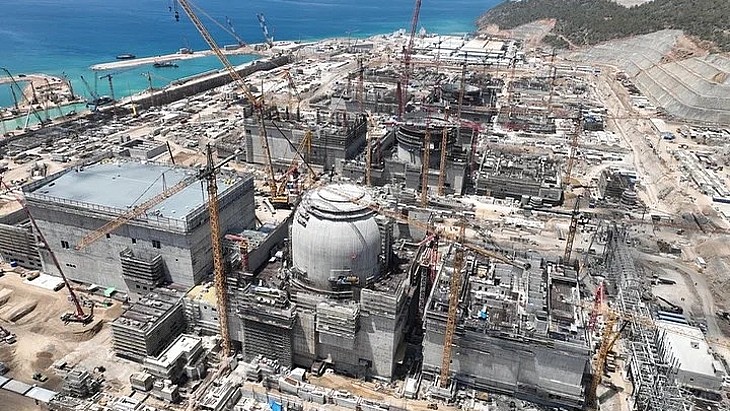
Unit 1 of Turkey's Akkuyuy plant is due to start up later this year (Image: Akkuyu NPP)
Global nuclear power generation is forecast to grow by almost 3% annually on average through to 2026, reaching a new record high by 2025, according to the International Energy Agency (IEA). More than half of new reactors expected to become operational during the outlook period are in China and India.
According to the IEA's Electricity 2024, which provides forecasts for electricity demand, supply and CO2 emissions up to 2026, global electricity demand is expected to grow at a faster rate over the next three years as the clean energy transition gathers speed, with all the additional demand forecast to be covered by technologies that produce low-emissions electricity.
While global growth in electricity demand eased slightly to 2.2% in 2023 due to falling electricity consumption in advanced economies, it is projected to accelerate to an average of 3.4% from 2024 through to 2026. About 85% of the increase in the world's electricity demand through to 2026 is expected to come from outside advanced economies - most notably China, India and countries in Southeast Asia.
However, record-setting electricity generation from low-emission sources - including nuclear power - should reduce the role of fossil fuels in providing power for homes and businesses. Low-emission sources are expected to account for almost half of the world's electricity generation by 2026, up from a share of 39% in 2023.
By 2025, nuclear power generation is forecast to reach an all-time high globally - exceeding the previous record set in 2021 - as output from France climbs, several plants in Japan are restarted, and new reactors begin commercial operations in many markets, including in China, India, South Korea and Europe. The IEA expects global nuclear generation to be almost 10% higher in 2026 compared with 2023.
Between 2024 and 2026, an additional 29 GW of new nuclear capacity is expected to come online globally. Asia remains the main driver of growth in nuclear power, with the region's share of global nuclear generation forecast to reach 30% in 2026.
The IEA says the increase in electricity generation from renewables and nuclear "appears to be pushing the power sector's emissions into structural decline". Over the next three years, low-emissions generation is set to rise at twice the annual growth rate between 2018 and 2023. Global emissions from electricity generation are expected to decrease by 2.4% in 2024, followed by smaller declines in 2025 and 2026.
"The power sector currently produces more CO2 emissions than any other in the world economy, so it's encouraging that the rapid growth of renewables and a steady expansion of nuclear power are together on course to match all the increase in global electricity demand over the next three years," said IEA Executive Director Fatih Birol. "This is largely thanks to the huge momentum behind renewables, with ever cheaper solar leading the way, and support from the important comeback of nuclear power, whose generation is set to reach a historic high by 2025. While more progress is needed, and fast, these are very promising trends."
In its updated Net Zero Roadmap, released in September last year, the IEA revised upwards the role of nuclear power. In the updated net-zero emissions (NZE) scenario, nuclear generating capacity more than doubles to reach 916 GWe in 2050.
At the COP28 climate change conference that concluded in December 2023, more than 20 countries signed a joint declaration to triple nuclear power capacity by 2050. Globally, that would mean an addition of 740 GW of nuclear capacity to the current stock of 370 GW.
According to the IEA, achieving this goal will require tackling the key challenge of reducing construction and financing risks in the nuclear sector. It also notes that momentum is also growing behind small modular reactor (SMR) technology. While technology's development and deployment "remains modest and is not without its difficulties", R&D is starting to pick up, it said.Researched and written by World Nuclear News. Nuclear output to reach new record by 2025, says IEA : Energy & Environment - World Nuclear News
